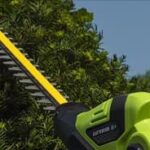As an Amazon Associate, this site earns commissions from qualifying purchases. For more information click here.
Hedge trimmers are great at well, trimming hedges. No doubt you have come across branches when you prune, so this raises the question. How thick can a hedge trimmer cut through? It would be nice if we could use just one tool for trimming, pruning and cutting hedges, bushes and trees. But is that doable or will there be problems?
A gas hedge trimmer can cut branches up to 3/4 inch thick, anything larger could damage its blades. If it is 1-2 inches thick you should use pruning shears or loppers. Use a saw if you want to cut something thicker.
What is the Cutting Capacity of Hedge Trimmers?
The cutting capacity of a hedge trimmer depends on much space there is between its teeth. The typical hedge trimmer spaces its teeth by 3/4 of an inch. Anything smaller than that and the blade will have no problems cutting it.
If the branch is 3/4 of an inch or smaller, the blade will cut through it easily. If it is thicker than that it will not fit between the teeth.
Ideally you should only cut branches less than 3/4 of an inch. Because if the branch is exactly that size, it might stress the motor. There are excptions, like the Echo 20 in. 21.2 cc Hedge Trimmer which has a 1 inch cutting capacity.
The bottom line is most hedge trimmers can only handle 3/4 inch thick branch. Forcing the tool to cut larger branches could overheat the engine, which can be dangerous..
If it seems like 3/4 of an inch is too small, keep in mind that hedge trimmers are designed mainly for trimming and maintaining hedges and cutting some plant growth. You can use it occasionally to cut branches and twigs, but only if they are thin and light.
We should also remember that not all hedge trimmers can trim branches. Gas powered models clearly can, but electric and battery powered trimmers might not have enough power. If you have a small trimmer, check the manual first if it is safe to cut branches. Otherwise you risk damaging the tool or overheating the motor..
Should I Use Hedge Trimmers to Cut Thick Branches?
If you have to cut a lot of thick materials like branches, twigs or small trees, it is better to use loppers, pruning shears or a chainsaw. If you work almost exclusively with hedges and only cut small branches, a hedge trimmer will be fine.
Hedge trimmers are designed not just to maintain hedges but also trim excess growth and various plants. Trimmers in particular are good at cutting and maintaining perennials like Stonecrop, False indigo, Coneflowers etc.
It also depends on how often you have to trim and cut branches. If you only do it on occasion then a hedge trimmer will get the job done. But if you have to trim trees of varying sizes, it is better to have a dedicated tool for the job.
Garden shears – the EZ Kut G2 Loppers s our pick here – can be used on small branches too. You might want to have both of them so you can trim hedges and remove branches with the shears effectively.
Do not use a hedge trimmer to cut thick tree branches. You will almost certainly damage the blades or worse the motor. Even a gas powered trimmer may not have the capacity to cut large branches. If the branch cannot fit between the teeth, use a chainsaw or pole saw.

What Type of Hedge Trimmer Makes the Thickest Cut?
There are three types of hedge trimmers: gas, electric and battery powered. Battery-run trimmers are the most affordable and ideal for small tasks, while gas operated hedge trimmers provide the most power.
Which is most suitable for cutting branches and hedge trimming? All three types are designed mainly for hedges. In terms of power gas operated trimmers are the best followed by electric and battery. The most powerful is not always the best. If you rarely trim small trees then there is no reason to use a gas powered trimmer.
Gas Powered Hedge Trimmers
These are the most powerful hedge trimmers available. These are run by two-stroke engines and can cut branches up to 3/4 of an inch thick. They are also the best suited for maintaining large hedges and cutting off plant growth.
If you want to use hedge trimmers to remove branches, a gas powered model is the best option. Electric and battery-run trimmers may also have 3/4 inch blade teeth, but what gas trimmers have is more power.
It takes more than the right blade size to trim branches. The tool must be powerful enough to last. In all likelihood you are going to cut several branches. An underpowered trimmer will eventually break down. Compared to electric and battery hedge trimmers, gas operated models can handle the job better.
Even though gas hedge trimmers are heavy duty, you should still use it mainly for trimming and maintain hedges. Trimming a few branches here and there is fine, but if you need to do that regularly, loppers or a chainsaw is better.
Electric Hedge Trimmers
Electric hedge trimmers are the best for light trimming. They are widely available, affordable and suited for small garden or yard work.
The biggest benefit of these hedge trimmers is they are quiet and do not vibrate like their gas counterparts. If you only need to work on a few small bushes and shrubs, these will be fine. And as long as it is plugged into a power source you do not have to worry about running out of power.
However that is also its biggest weakness. Yes an electric trimmer gives you continuous power, but it is not enough for heavy duty tasks. Few if any are capable of cutting branches the way gas trimmers can.
If you need to trim branches with a hedge trimmer, get one that runs on gas. You can only use electric hedge trimmers for bushes and shrubs. To cut branches you will need a pole saw or another cutting tool.
Battery Operated Hedge Trimmers
These are the quietest hedge trimmers available today. They are also the most portable. Since these trimmers run on a rechargeable battery you won’t be slowed down by a cord. When the battery power starts to drop, you can always recharge it.
This convenience comes at a price though. For one thing they are not suitable for removing branches. Battery-run hedge trimmers are just too small to do any cuts. You could end up damaging its blades if you try to use it on a branch.
Frequently Asked Questions
How will I know my hedge trimmer cutting capacity?
The cutting capacity is in your owner’s manual. Another way to find out is to measure how far apart the teeth are. If it is 3/4 of an inch that is the maximum branch width the hedge trimmer can cut.
My hedge trimmer has a 3/4 inch capacity, but when I try to cut a branch, it does not work. Why?
The 3/4 inch is the maximum capacity you can put between the blades. In some cases the trimmer cam cut it. With other models however, the blade needs a bit of space –or less than ¾- to move. If it is an exact fit, the motor may not be able to power the blades. If the engine is struggling you need a more powerful hedge trimmer or use another cutting tool.
Why is my hedge trimmer getting jammed when I trim twigs and branches?
It means the hedge trimmer does not have enough power. Even if the blade is large enough to fit these branches, the trimmer must still have a powerful engine or motor. Without it the blade will struggle and could eventually just give out.
What are the best alterative tool for cutting branches?
Garden shears, pruning shears and loppers will work just as well. In fact many prefer to use these tools in combination with a hedge trimmer. Use the trimmer for the hedge and perennials then switch to loppers or pruning shears to remove branches.

I love the outdoors and all the tools for maintaining gardens, yards and lawns. The only thing I am more passionate about is sharing what I know about garden and outdoor equipment.


